材料概论材料科学概论课件双语
材料科学概论英文版ch8-2 (1)
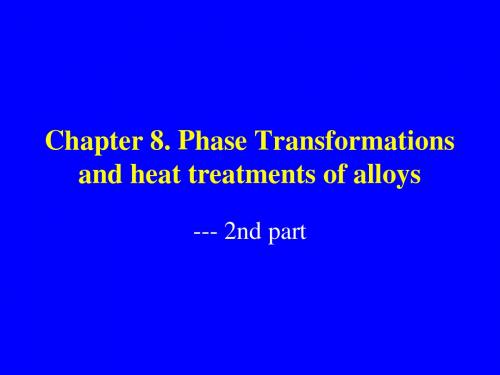
Heat Treatment of Steels
Martensite has the strongest microstructure and can be made more ductile by tempering. Therefore the optimum properties of quenched and tempered steel are realized if high content of martensite is produced. Problem: difficult to maintain same conditions throughout volume of steel during cooling: surface cools more quickly than interior, producing range of microstructures through volume. The martensitic content, and the hardness, will drop from a high value at the surface to a lower value in the interior of the piece. Production of uniform martensitic structure depends on • composition • quenching conditions • size + shape of specimen• Anneຫໍສະໝຸດ ling, Stress Relief
• More on Heat Treatment of Steels
• Precipitation Hardening
Annealing
《材料概论第》PPT课件
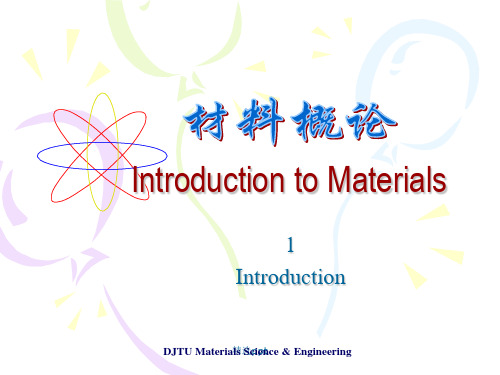
• Subatomic level Electronic structure of individual atoms that defines interaction among atoms (interatomic bonding).
• Atomic level Arrangement of atoms in materials for the same atoms can have different properties, e.g. two forms of carbon: graphite and diamond.
Tin
210 thousand
Molybdenum Titanium W Uranium Silver Gold Platinum
121 thousand 95 thousand 43 thousand 39 thousand 14 thousand 1.9 thousand 270 ton
2020/12/21
6
2020/12/21
精选ppt
7
1.1 材料科学与工程的发展史
芳纶纤维
Ceramics 10,000 BC 5,000 BC 1,000 BC
2020/12/21
DJTU Materia精ls 选Scpipent ce & Engineering
8
2020/12/21
DJTU Materia精ls 选Scpipent ce & Engineering
•Bauxite
101 million
•Coal
4,573 million
•Iron ore
943 million
•Cement
1121 million
材料概论 双语 第三章ppt

Nuclear Fuels
The History of Chinese Ceramics
(1). 3 000 B.C : Potters in Henan and Gansu is technically superior.
After 600 A.D : Ceramics is adaptable to higher firing temperatures and more translucent and white after firing.
The classification of ceramic
Traditional ceramics
Traditional ceramics are derived and processed from clay or nonclay minerals.
Traditional ceramics are usually heavy,fragile( 脆)
Classification based on applications
Advanced ceramics
Advanced ceramics are developed form rather simple chemical compounds , and advances in processing which have provided greater control over their structures. Advanced ceramic: the scale of the raw materials and microstructures, including the crystal grains, crystal interface, pores and defects is at the level of microns.
材料科学基础双语课件
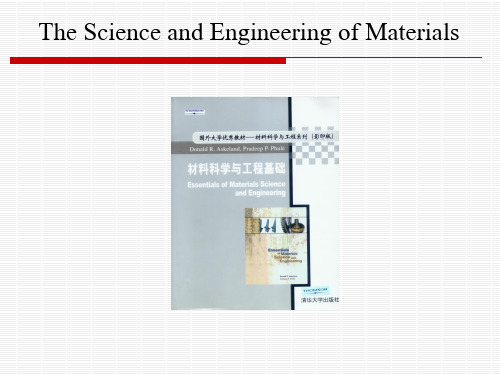
grain structure, or the presence of defects in the atom
packing) or to fabricate the material into the desired shape.
extra material, joining parts (e.g., by soldering or welding),
forming (forging, rolling, bending, etc.), or compacting particles which are then fused together (sintering, used for
gases (and most engineering materials are used in solid
form).
1.1 What is Materials Science and Engineering?
It may seem abstract and remote from real engineering to
The Science and Engineering of Materials
Aim
English atmosphere: speaking, reading, writing and lisห้องสมุดไป่ตู้ening; Specialty vocabulary; Specialty knowledge;
form. As this mixture solidifies, different structures form as a function of temperature. The phase diagrams that provide
材料概论 材料科学概论 双语课件
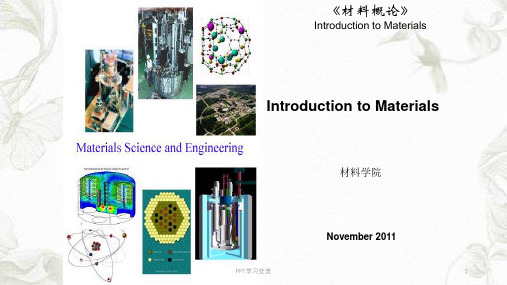
Artifical Bone
Resomer® Resorbable Polyester:Polylactide, Polyglycolide or the copolymers
—Boehringer Ingelheim KG
PPT学习交流
17
PPT学习交流
18
PPT学习交流
19
1.1 Materials and Material Science
特点: 具有一定的成分和配比;
可成型加工; 保持一定形状和外观; 具有使用价值并可回收再利用。
PPT学习交流
23
保持一定形状和外观 可成型加工
具有使用价值
PPT学习交流
24
Essential role of materials: indispensable to our society as food, energy and information.
1.1.1 Definition Constitute: The materials making up the surrounding world consist of discrete particles, having a submicroscopic size.
组成:构成物质世界的材料由具有亚 微观尺度的各种微粒子组成。
影响材料使用的因素
materials behavior availability
cost
synthesis and production method
processing techniques
environmental acceptability
PPT学习交流
20
1.1 Materials and Material Science
材料概论英文版 武汉理工大学

Material: Solids used by man kind to produce items which constitute the support for his living environmentCharacteristics of materials◆Have certain compositions;◆Can be processed;◆With certain shape and color;◆Can be used and reused or recycled.◆特点:☐具有一定的成分和配比;☐可成型加工;☐保持一定形状和外观;☐具有使用价值并可回收再利用。
材料性能的决定因素◆组成材料的各元素的原子结构,◆原子间的相互作用、相互结合,◆原子或分子在空间的排列分布和运动规律,◆原子集合体的形貌特征。
Classification of materials◆Atomic structures◆Nature of chemical bonds:☐ Metallic bond 金属键☐ Ionic bond 离子键☐ Covalent bond 共价键☐ Secondary bond 次价键☐ Van der Waals bond 范德华力☐ Hydrogen bond 氢键Classification:◆metals and their alloys:- metallic bonding◆Organic polymers: Covalent bonding & secondary bonding◆Ceramics:Ionic bonding & covalent bondingMetals and their alloys:◆ are good conductors of heat and electricity;◆ are opaque to visible light;◆ are hard, rigid;◆ can undergo plastic deformation◆ have a high melting temperature (Tm).Organic polymers:◆made up of long-chain molecules;◆ are electrical and thermal insulators;◆ are light and easily formable;◆ the best-known organic polymers are:☐ poly (vinyl chloride) (聚氯乙烯,PVC);☐ polyethylene (聚乙烯,PE);☐ polystyrene (聚苯乙烯,PS)。
英文版-材料概论
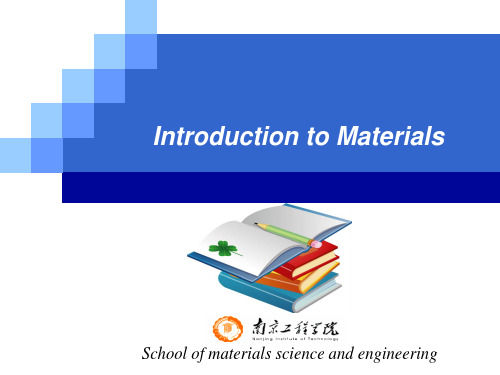
《材料科学概论》课件

陶瓷材料的应用
总结词
耐高温、硬度高
详细描述
陶瓷材料具有优良的耐高温和硬度高的特性,广 泛应用于高温炉具、航空航天、机械等领域。
总结词
绝缘性好、化学稳定性高
陶瓷材料的应用
详细描述
陶瓷材料具有良好的绝缘性能和化学稳定性,能够适应各种恶劣 环境下的使用需求。
总结词
生物容性和生物活性,能够促进骨组织 再生和修复。
02
CATALOGUE
材料的性质
材料的物理性质
导热性
光学性质
描述材料传输热量的能力。金属通常 具有良好的导热性,而隔热材料如玻 璃纤维或泡沫则具有较低的导热性。
涉及材料对光的吸收、反射和折射等 特性。例如,镜子利用玻璃的高反射 性,而透明玻璃则允许光线通过。
电导率
衡量材料传导电流的能力。金属是电 的良导体,而塑料和陶瓷则是电的不 良导体。
材料的化学性质
耐腐蚀性
材料抵抗化学物质(如酸、碱、 盐等)腐蚀的能力。例如,不锈 钢因其抗腐蚀性而在许多应用中
得到使用。
抗氧化性
材料在高温下抵抗氧化(即生锈或 腐蚀)的能力。某些金属如金和铂 具有很高的抗氧化性。
稳定性
材料在各种环境条件下保持其化学 性质的能力。例如,食盐在水中溶 解,但在干燥条件下会结晶。
高分子材料的应用
总结词
质轻、强度高
VS
详细描述
高分子材料具有质量轻、强度高的特点, 能够有效地减轻产品重量,提高使用性能 。
高分子材料的应用
总结词
绝缘、耐腐蚀
详细描述
高分子材料具有良好的绝缘性能和耐腐蚀性 ,能够适应各种复杂环境下的使用需求。
高分子材料的应用
总结词
材料概论课件翻译

•材料概论•材料简介•课程安排章Ⅰ简介2小时第Ⅱ章材质属性6小时章Ⅲ高分子材料12小时章Ⅳ复合材料6小时第Ⅴ陶瓷材料2小时章Ⅶ金属材料2小时评论2小时总32hrs第一章材料概述•第一章简介材料•简介1.1材料简介1.2材料周期1.3材料家庭•1.1材料简介1.1.1定义材料1.1.2材料科学与工程1.1.3材料的发展•1.1.1材料定义•材料已使他们有用的机器(机器)结构(建筑物),宇宙(宇宙)的物质,设备(设备),产品(产品),系统(系统)。
•例如,PDF 1:4-21;简史材料,PDF 1:22-361.1.2材料科学与工程材料科学与工程(MSE)已成为一个主要的研究领域,一个关键的涉及到许多其他领域。
•MSE的定义由美国科学院研究所的研究,涉及到有关的知识的组成,结构和材料处理其性能和用途的发现和应用。
•“科学”专注于发现的材料,这反过来又导致理论解释结构如何组成,性质和行为的性质。
“工程”,另一方面,涉及使用的科学,以开发(开发),准备,修改和申请材料,以满足特定的需求。
材料科学与工程是跨学科或跨学科(交叉学科),拥抱(包含)领域,如冶金(冶金学),陶瓷,固态物理,高分子物理与化学,等等。
科学家和工程师是专家谁是完全参与调查和材料设计。
•为什么要研究材料科学与工程•要了解材料•要选择材料•设计材料•1.1.3材料的发展•材料飞机第一架飞机纯铝于1930的Al合金的开始1970 CC复合材料•材料成熟度曲线•1.2材料循环的制造商(制造业者)开始的原料如原油,天然气,树木,和棉花,以化学化合物,如乙烷,三氯甲烷,氟化氢,包括氯化乙烯。
从这些原料的单体(单分子)的生产和乙烯,甲基丙烯酸甲酯和氯乙烯。
•如果我们使总的材料循环效率,从而保护环境和自然资源,为子孙后代,我们必须制定正确的态度和习惯,在我们的公民(养成)。
•1.3材料家庭•聚合物1。
电气绝缘2。
保温3。
耐化学性4。
极轻的重量5。
透明度6。
材料科学导论(英文课件)--青岛科技大学diffusion

Interstitial diffusion is generally faster than vacancy diffusion because bonding of interstitials to the surrounding atoms is normally weaker and there are many more interstitial sites than vacancy sites to jump to. Requires small impurity atoms (e.g. C, H, O) to fit into interstices in host.
∂c ,则单元体积中溶质积累速率为 ∂t
∂c ⋅ dx = J 1 − J 2 ∂t
(Fick’s
first law)
∂c J 1 = − D( ) x ∂x
⎛ ∂c ⎞ J 2 = − D⎜ ⎟ ⎝ ∂x ⎠ x + dx
Fick’s first law
(即第二个面的扩散通量为第一个 面注入的溶质与在这一段距离内溶 质浓度变化引起的扩散通量之和)
Chapter Outline
Factors that influence diffusion Diffusing species Host solid Temperature Microstructure
What is diffusion?
Diffusion is material transport by atomic motion.
Steady-State Diffusion: Fick’s first law
Fick’s first law: the diffusion flux along direction x is proportional to the concentration gradient
2.1 材料概论-陶瓷 双语

32
Ceramic Armour les
34
1.4 陶瓷的发展趋向
纳米陶瓷 nano-ceramic 特性:
原材料粉末 raw materials powder颗粒为纳米级 nano-level grains;
Majority多数 has ionic (in salt compounds) or metallic and nonmetallic elements (as in oxides Al2O3, MgO, SiO2)
主要组分:硅酸盐化合物 在美国,陶瓷泛指硅酸盐材料,又称
为传统陶瓷或普通陶瓷。包括日用陶瓷、 工业用陶瓷、一般玻璃、水泥、耐火材 料等。
3013陶瓷的发展瓷器传统陶瓷高铝质粘土和瓷土的应用釉的发明原料纯化陶瓷工艺的发展陶瓷理论的发展先进陶瓷微米级纳米陶瓷高温技术的发展显微结构分析的进步性能研究的深入无损评估的成就相邻学科的推动外汇是一种以外币表示的用于国际间结算的支付手段
《材料概论》
Introduction to Materials
• Ceramic can be defined as inorganic, nonmetallic materials.
陶器 ---瓷器
表面效果 制作材料 烧制温度 敲击声音
陶器
胎料 普通的粘土
瓷器
瓷土(高岭土)
温度 一般<1000度 一般>1100度
表层 不施釉或低温釉
多施釉
胎体坚固致密,
吸水 胎质粗松,断面 断面基本不吸水,
Advanced Ceramics
Cutting tools
Zirconia toughened alumina 氧化锆增强氧化铝
材料科学与工程导论(双语)Chater_8(可编辑)
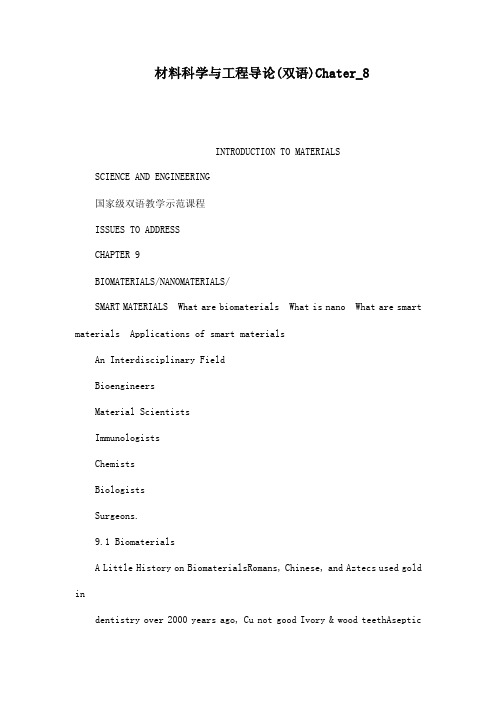
材料科学与工程导论(双语)Chater_8INTRODUCTION TO MATERIALSSCIENCE AND ENGINEERING国家级双语教学示范课程ISSUES TO ADDRESSCHAPTER 9BIOMATERIALS/NANOMATERIALS/SMART MATERIALS What are biomaterials What is nano What are smart materials Applications of smart materialsAn Interdisciplinary FieldBioengineersMaterial ScientistsImmunologistsChemistsBiologistsSurgeons.9.1 BiomaterialsA Little History on BiomaterialsRomans, Chinese, and Aztecs used gold indentistry over 2000 years ago, Cu not good Ivory & wood teethAsepticsurgery 1860 ListerBone plates 1900, joints 1930Turn of the century, synthetic plastics came intouseWWII, shards of PMMA unintentionally gotlodged into eyes of aviatorsParachute cloth used for vascular prosthesis1960- Polyethylene and stainless steel beingused for hip implantsWhat’s a biomaterial?1980 - Passive and inert point of viewAny substance or drugs, of synthetic or naturalorigin, which can be used for any period aloneor as part of a system and that increases orreplaces any tissue, organ or function of thebody.1990 ? Active point of viewNon-living material used in a medical deviceand designed to interact with biologicalsystems.Classification of BiomaterialsFirst generation: INERT Do not trigger any reaction in the host: neitherrejected nor recognition “ do not bring anygood result”Second generation: BIOACTIVE Ensure a more stable performance in a longtime or for the period you wantThird generation: BIODEGRADABLE It can be chemically degraded or decomposedby natural effectors weather, soil bacteria,plants, animalsMean Features for Medical ApplicationsBIOFUNCTIONALITY Playing a specific function in physical andmechanical termsBIOCOMPATIBILITY Concept that refers to a set of properties that amaterial must have to be used safely in abiological organism The ability of a material to perform with an appropriate host response in a specificapplication Host response: the reaction of a living system to the presence of a material.What is a biocompatible material?1 Synthetic or natural material used in intimatecontact with living tissue it can be implanted,partially implanted or totally external.2 Biocompatible materials are intended tointerface with biological system to EVALUATE,TREAT, AUGMENT or REPLACE any tissue,organ or function of the body A biocompatible device must be fabricated frommaterials that will not elicit an adverse biologicalresponse.Biocompatible material features1 Absence of carcinogenicity 致癌性 the abilityor tendency to produce cancer2 Absence of immunogenicity 致免疫性absence of a recognition of an external factorwhich could create rejection3 Absence of teratogenicity 致畸性 ability tocause birth defects4 Absence of toxicityWhat’s a bi odegradable implant Once implanted, should maintain its mechanical properties until it is no longerneeded and then be absorbed and excretedby the body, leaving no trace Biodegradable implants are designed to overcome the disadvantages of permanentmetal-based devices.BiomaterialsPolymeric biomaterialsBioceramicsMetallic biomaterialsBiocompositeBiologically based derived biomaterials Polymeric Biomaterials: Adv. & Disadv.聚甲基丙烯酸甲酯,俗称“有机玻璃”。
材料科学导论(英文课件)--青岛科技大学Polymer structures and properties
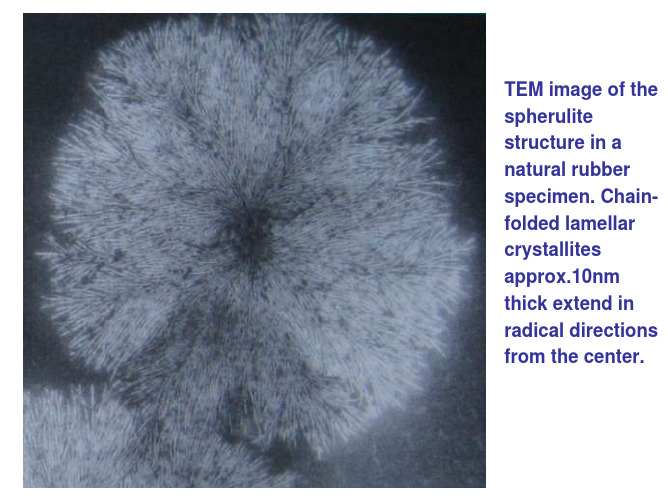
The chain-folded structure for a plate-shaped polymer crystallite.
Chapter 4 Polymer Structures, Applications & Processing
Introduction
• Natural polymers: (1) Derived from plants and animals, such as wood, rubber, cotton, wool, leather and silk. (2) proteins, enzymes, starches, and cellulose in biological and physiological process. • Synthetic polymers: plastics, rubbers, and fiber materials. After WWII, the field of materials has been virtually revolutionized by the advent of synthetic polymers.
TEM image of the spherulite structure in a natural rubber specimen. Chainfolded lamellar crystallites approx.10nm thick extend in radical directions from the center.
Hydrocarbon molecules
Hydrocarbon molecules: hydrogen and carbon. Intramolecular bond: covalent. Saturated and unsaturated molecules: saturated – all the bonds are single ones (CH4); unsaturated – molecules have double and triple covalent bonds (CH2=CH2, CH≡CH).
《材料科学概论》课件

02
材料的基本性质
材料的物理性质
导热性
描述材料传输热量的能力。金属 通常具有良好的导热性,而隔热 材料如玻璃纤维或泡沫塑料则具 有较低的导热性。
电导率
衡量材料传导电流的能力。金属 是电的良导体,而塑料和陶瓷则 是电的不良导体。
光学性质
涉及材料对光的行为,如反射、 折射、吸收和散射等。例如,镜 子利用其高反射性来反射光。
详细描述
材料科学是研究材料的组成、结构、性能及其应用的学科,旨在通过实验、理论分析和计算模拟等方法,探索材 料的内在规律和特性,为新材料的研发和应用提供理论支持。
材料科学的重要性
总结词
材料科学在人类文明进步、科技发展、国民经济等方面具有重要作用。
详细描述
材料科学是现代工业和科技发展的重要基础,对人类文明进步和国民经济具有重要意义。新材料的研 发和应用为能源、环保、医疗、交通等领域提供了关键技术支持,推动了科技进步和社会发展。
磁学性能测试
包括磁导率、磁化强度、矫顽力等, 用于研究材料对磁场的作用和响应。
材料的化学性能测试
化学稳定性测试
包括耐腐蚀性、抗氧化性、耐候性等,用于 评估材料在化学环境中的稳定性。
腐蚀性能测试
包括电化学腐蚀、化学腐蚀等,用于评估材 料在特定环境中的耐腐蚀能力。
催化性能测试
通过研究材料对化学反应的催化作用,了解 其反应机理和活性。
硬度测试
通过测量材料表面抵抗被压入或划痕的能力 ,反映其硬度。
材料的其他性能测试
生物性能测试
针对生物相容性、生物活性等进行测试,用于评 估材料在生物医学领域的应用潜力。
渗透性测试
针对气体、液体等在材料中的渗透行为进行测试 ,用于评估材料的密封性能等。
材料概论 双语玻 玻璃

P2O5 And phosphate glasses
Complex oxide glasses
4.2 Preparation Technologies of Glasses
Speaker : 吕金建 B10010624
Preparation Technologies of Glasses
The
Tg: Glass transition temperature at Tg
Second
derivative thermodynamic properties, namely heat capacity, thermal expansivity and compressibility undergo more or less sudden changes
Dependence of rate of crystallization of an undercooled liquid on temperature
4.2.1 Preparation of Glasses
In the case of good glass forming materials like SiO2 ,GeO2 or B2O3, the required rate of cooling of the melts is remarkably low because the maximum crystallization velocities in these materials are themselves very low It appears that any liquid can be quenched into a glass provided the required high degree of quenching rate is achieved.
材料概论 双语 第五章 水泥
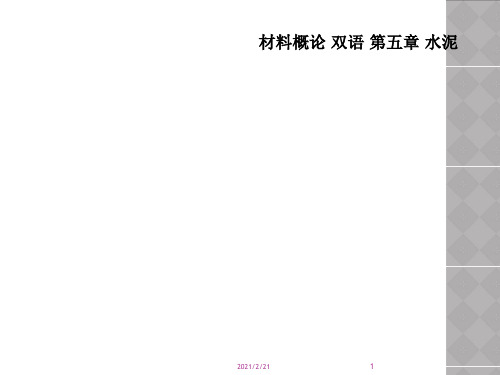
2021/2/21
15
Consumer Product Safety
• Prolonged contact between wet cement and concrete mixtures should be avoided.
• Contact with freshly mixed cement, mortar, grout ,or concrete may cause skin irritation or burns.
2021/2/21
13
Properties of Concrete
• Freshly mixed concrete can be formed into practically any shape.
• Concrete can withstand heat and fire. While it can lose strength when the temperature high enough.
C-S-H = poorly crystalling or amorphous calcium silicate hydrate of unspecified composotion
Properties or reactions
AR = alumina ratio ASR = alkali silica reaction
mixture of limestone and clay , or other materials of similar bulk , composition and sufficient reactivity ultimately to a temperature of about 1450℃ .partial fusion occurs and nodules of clinker are produced . The clinker typically has a composition in the region of 67 % CaO, 22% SiO2, 5% Al2O3 , 3%Fe2O3 , 3%other components , and normally contains f20o21u/2/r21major phases , called alite , belite , 3
《材料专业英语翻译》课件

Material application
Material application refers to the utilization of materials in various industries and products
Materials are used in a wide range of fields, including construction, transportation, electronics, energy production, and healthcare
Course objectives
To improve learners' understanding of materials science and engineering concepts in English
To enhance learners' professionalism in English language skills through practical application
01
Introduction
Course Introduction
This course is designed to provide learners with a comprehensive understanding of materials science and engineering concepts in English
Product manual translation
要点一
要点二
要点三
Product manual translation involves converting user manuals, operation instructions, and other product related documents from one language to English
- 1、下载文档前请自行甄别文档内容的完整性,平台不提供额外的编辑、内容补充、找答案等附加服务。
- 2、"仅部分预览"的文档,不可在线预览部分如存在完整性等问题,可反馈申请退款(可完整预览的文档不适用该条件!)。
- 3、如文档侵犯您的权益,请联系客服反馈,我们会尽快为您处理(人工客服工作时间:9:00-18:30)。
材料的结构
– Structure – properties – processing
结构-性能-工艺之间的关系
1.1 Materials and Material Science
材料的重要性
石器时代陶器时代青铜器时代铁器时代
材料的发展史,就是人类社会的发展史。
材料的发展历史
金 青铜 铁
高分子材料
Economy: costs related to materials, processing and energy
Environment: environmental behavior of the material
Resources & Recycling: resources and possible recycling
木材 皮革 骨
纤维
相
皮胶
对
占
有
复合材料
量
稻草杆砖
纸
钢 合金钢
金属材料
橡胶 赛璐珞
耐热合金
火石 陶
瓷 玻璃
无机非金属材料
水泥 耐火材料
通用高分子
纤维增强塑料 金属陶瓷
玻璃态金属 微合金钢
功能高分子 高温高分子 高强高模高分子
各种基体复合材料
先进功能陶瓷 韧性工程陶瓷
5000 公元前
0 公元
1000 1500 1800
➢ concrete: an agglomeration of cement, sand and gravel
1.1.3 Properties
Mechanical properties:
the behavior of materials deformed
by a set of forces.
➢ 弹性
—Boehringer Ingelheim KG
1.1 Materials and Material Science
影响材料使用的因素
materials behavior availability cost synthesis and production method processing techniques environmental acceptability
特点: 具有一定的成分和配比;
可成型加工; 保持一定形状和外观; 具有使用价值并可回收再利用。
保持一定形状和外观 可成型加工
具有使用价值
Essential role of materials: indispensable to our society as food, energy and information.
1900
1940 1960
1980
1990
2000
2010
时间 / 年
(1)石器时代:
旧石器时代--原始人采用天然的石、木、竹、骨等材料作 为狩猎工具;
新石器时代--公元前6000年,人类发明了火,掌握了钻木 取火技术,用以烧制陶瓷。瓷器的出现已成为中华民族文化的 象征之一,对世界文化产生过深远的影响。
Polymeric Biomaterials
•人工心脏:
聚酯、聚氨酯、环氧树脂
•人工肺:
硅橡胶半透膜
•关节(肩、髋、膝):
聚四氟乙烯
•人工肾(kidney):
透析膜 •……
Atrifical Heart
聚酯编织管 环氧树脂
聚酯
硅油 聚醚型聚氨酯Βιβλιοθήκη Artifical Bone
Resomer® Resorbable Polyester:Polylactide, Polyglycolide or the copolymers
➢ 抗腐蚀能力 Corrosion resistance:
atmospherically, chemically (salts, sour, alkali)
1.1.4 Use of materials
Factors related to the use of a material are:
Quality: properties and functions
➢ 电性能 Electric properties ➢ 磁性能 Magnetic properties ➢ 热性能 Thermal properties ➢ 光性能 Optical properties
• Chemical properties: the behavior of material in a reactive environment.
材料科学:
基于现代科学技术,一方面,利用 化学手段研究材料的化学成分、化学键 和合成方法; 另一方面,借助物理学 方法,研究材料性质, 主要根据晶体物 理和固体物理描述材料结构和性能的关 系。
The four basic aspects of materials science and technology
组成:构成物质世界的材料由具有亚 微观尺度的各种微粒子组成。
Materials:
defined as solids used by man to produce items which constitute the support for his living environment.
Character: materials have certain compositions; can be formed; with certain shape and color; can be used and reused or recycled.
Materials Science studies:
• 化学组成、化学键、合成方法:
chemical composition, chemical bonds and synthesis methods
• 特性: nature of materials
• 结构与性能的关系:
describe the relationship between structure and properties based on crystal physics and solid physics
金属键 离子键 共价键 次价键
Metallic bond Ionic bond Covalent bond
secondary bond
范德华力 Van der Waals bond 氢 键 Hydrogen bond
Classification: ➢ metals and their alloys:
1.1 Materials and Material Science
1.1.1 Definition Constitute: The materials making up the surrounding world consist of discrete particles, having a submicroscopic size.
• Organic polymers: ➢ made up of long-chain molecules; ➢ are electrical and thermal insulators; ➢ are light and easily formable; and ➢ the best-known organic polymers are:
Elasticity
➢ 塑性
Plasticity
➢ 强度
Strength
➢ 硬度
Hardness
➢ 韧性
Toughness
➢ 疲劳特性 Fatigue behaviour
➢ 耐磨性 Abrasion resistance
• Physical properties: the behavior of materials subjected to the action of temperature, electric or magnetic fields, or light.
Types of materials
• Metals and their alloys: ➢ are good conductors of heat and
electricity; ➢ are opaque to visible light; ➢ are hard, rigid; ➢ can undergo plastic deformation ➢ have a high melting temperature (Tm).
原始人打造的石器
印地安人用的石斧
(2)青铜器时代:这是人类社会出现 最早的金属材料,中国历史上曾有过灿 烂的青铜文化。
青铜宝剑
青铜鼎
青铜编钟(chimes)
hoe
(3)铁器时代:用铁作为材料来制造农具,铁在农 业上的广泛应用,推动了以农业为中心的科学技 术日益进步;以钢铁为中心的金属材料大规模发 展,有力地摧毁了封建社会的生产方式,萌发了 资本主义。
- poly (vinyl chloride) (PVC); - polyethylene (PE); - polystyrene (PS).
• Ceramics/inorganic nonmetallic materials: ➢ the combination of metallic elements (Mg,
《材料概论》
Introduction to Materials
Introduction to Materials
材料学院
November 2011
Chapter 1 Introduction to Materials
Content
-Definition
材料的定义
-Types
材料的类型
-Structure
Al, Ti, ...) with non-metallic elements (o); ➢ have high mechanical and thermal
